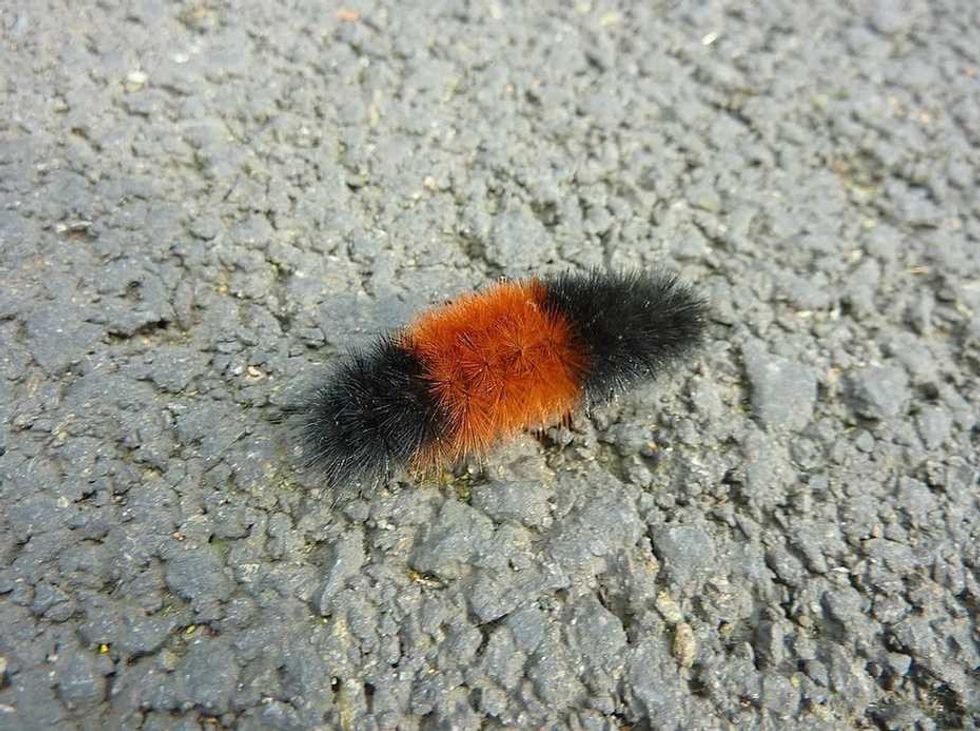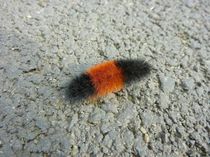Woolly bear caterpillars (Pyrrharctia isabella), also known as a woolly worm, fuzzy bear, black-ended bear, or banded woolly bear, are the caterpillar stage of the isabella tiger moths (woolly bear moth). These cold-blooded invertebrates get their name because of their furry appearance with reddish-brown and black bands on their segmented body that is divided into 13 parts.
The name Pyrrharctic isabella was formally given in 1797 by James Edward Smith. Found widely in the wetlands of Canada, North, and Central America, and fuzzy bears are known for their tolerance to the cold winter weather.
They hibernate through the winter near a food source and emerge in spring when the temperature reaches around 50 degrees. The adult woolly worm moth is about an inch in size with thread-like antennae.
They have siphoning mouthparts and survive on nectars from flowers. They are attracted to lights.
They don't live long and are lesser known than their caterpillars. Woolly bears have several stages, namely, woolly bear cocoon, woolly bear caterpillar, butterfly.
According to folklore, it is believed that it can be deciphered whether the coming winter weather would be mild or harsh by observing the bands on a woolly bear caterpillar. Dr. Howard Curran, who was the curator of insects at the American Museum of Natural History, conducted a study on woolly bear caterpillars in 1948 that lasted eight years.
This story, published in the New York Herald Tribune, popularized woolly worm and their alleged winter weather prediction.
To know more about these fascinating animals, read on as we have gathered a set of interesting facts about them for you to read. You can also read up more articles on the viceroy butterfly and caterpillars.
Woolly Bear Interesting Facts
What type of animal is a woolly bear?
Woolly bears are a type of caterpillars. They are the young larval forms of the isabella tiger moth.
What class of animal does a woolly bear belong to?
Woolly bears belong to the class of Insecta.
How many woolly bears are there in the world?
They are very common and widespread across northern and central parts of North America. However, their exact number is not known.
Where does a woolly bear live?
They live in meadows, woodlands, marshes, parklands, and pastures. They could be found even in your backyards, roadsides, and under logs of wood. They usually use low-growing plants and some trees as their host. They are generally widely distributed in the United States, southern Canada, Florida, Texas, and Mexico.
What is a woolly bear's habitat?
Woolly bear caterpillar habitat consists of wetlands wherever there is a good source of food. They prefer habitats that are moist and suitable for overwintering, like marshes or meadows. They can withstand extremely cold temperatures.
During winter, they are known to hibernate. Their bodies produce an antifreeze called cryoprotectant, which helps them survive through the cold temperatures even as bad as -90 degrees F. They emerge from their hibernation in the warm early spring.
They feed themselves on leaves and safe spaces to spin and pupate. The cocoon is made by using silk and its fur-like setae. They transform and emerge as moths in May or early June.
Who do woolly bears live with?
The Woolly bear caterpillar moth is generally a solitary being. They live and feed in groups after hatching. But as they mature, they go in separate ways.
How long does a woolly bear live?
The Pyrrharctia isabella is known to remain in the caterpillar stage for a few years before transforming in areas where the winters are long. The longest woolly bear caterpillar life cycle has been recorded as 14 years. However, after the caterpillar transforms, the adult lives only for one or two weeks, during which it mates and lays eggs.
How do they reproduce?
At night, adult females emit pheromones from a scent gland situated on the tip of the abdomen. This chemical signal attracts the males. They can sense the scent using their antennae, and it helps them locate the female moth for mating.
The female lays the eggs on suitable plants that can act as a source of food. The host plant serves as food for the larvae after the eggs hatch within two weeks.
Two broods of eggs are laid every year; therefore, there are two generations of woolly worms a single year. The first generation pupates during the summer in May. The second-generation pupates in August overwinter at convenient spots, hibernating as larvae.
What is their conservation status?
They are common and widespread in North America. However, their conservation status has not been evaluated by IUCN or the International Union for Conservation of Nature. Their population is not declining and is deemed to be 'secure' according to NatureServe.
Woolly Bear Fun Facts
What do woolly bears look like?
A Woolly bear caterpillar is covered with bristles or fur-like setae. The bristles in the middle segments are brown, while both the end segments are black. These species bands give them a striped look.
As they molt, the black reduces, and they become more reddish-brown. The adults, known as the isabella tiger moths, are a dull yellow-orange with small heads, pointed forewings, and paler hindwings. They have small black spots on the thorax region and the edge of their wings.
The adults exhibit sexual dimorphism. The hindwings of the male moth are pale orange, while that of the female moth are rosy. Sometimes, they might be confused with different species of the woolly bear.
How cute are they?
These caterpillars species are very cute with their banded, black, and brown coats of bristly hair.
How do they communicate?
During mating, the females communicate with males by emitting pheromones with which the male moths can locate them. In the face of potential danger, a woolly worm curls up and pretends to be dead upon touching.
How big is a woolly bear?
A woolly bear caterpillar can grow up to 1.5-2.5 in (3.8-6.3 cm), and they weigh less than 1 oz (28 g). An adult moth has a wingspan of 1.5-2 in (3.8-5 cm).
A woolly worm is almost the same size as that of a yellow woolly bear caterpillar which is the larval form of the Virginian tiger moth, which is a different species.
How fast can a woolly bear move?
The caterpillar's speed is relatively fast and swift. They can move as fast as 0.04 mph (0.07 kph).
How much does a woolly bear weigh?
A woolly bear weighs less than an ounce.
What are their male and female names of the species?
There are no distinct names for males and females. A caterpillar of this species is commonly known as a woolly bear caterpillar (Pyrrharctia isabella). There are no specific names for a group of these caterpillars either.
What would you call a baby woolly bear?
A woolly worm caterpillar is the young one of the isabella tiger moth. The baby in the larval stage is called a larva or a caterpillar, whereas, in the pupal stage, it is called a pupa. There are no specific names for the woolly bear caterpillars or pupae.
What do they eat?
They are herbivores. The woolly bear caterpillar diet usually consists of dandelions, burdock, clover, grasses, corn, asters, birches, elms, maples, or sunflower. To eliminate parasites, they eat leaves containing beneficial alkaloids like comfrey, and groundsel. Adults suck nectar from flowering plants using their siphoning mouthparts.
Are they poisonous?
No, a woolly bear caterpillar is not poisonous. However, some people with sensitive skin might develop dermatitis upon touching the caterpillar's bristles. This had led to the 'woolly bear caterpillar poisonous' theory. Unlike most hairy caterpillars, a woolly worm is harmless.
Would they make a good pet?
Yes, you can raise them as your pets by providing proper habitat and taking care of them. You can release them once they become moths. Children raise the caterpillar for school projects as well.
Did you know...
Fuzzy bears are adept at surviving through winter. Before forming cocoons, the second generation caterpillars hibernate over the period of winter. They produce organic anti-freezers in the form of glycerols. Even though their body freezes, their inner cells will be protected by the anti-freezers. They are reported to have survived even inside an ice cube.
A banded woolly bear, like every other insect, has six legs. Four of them, called prolegs, will be gone as a woolly bear's life cycle comes to an end.
To care for a woolly worm, you need to provide them with its ideal habitat. Make a mini habitat inside a jar and provide it with a twig to build a cocoon, plants to feed on, and mist your tiny little garden regularly for your tiny little friend.
The caterpillar will build a cocoon in the spring. Remember that you should free your pet after feeding it for a few days once the moth emerges.
When the Dr. Howard Curran, curator at the American Museum of Natural History, decided to study the caterpillar's 'wider the brown bands, milder the winter and wider the black bands, severe the winter' theory in 1948, there was a lot of furor in local media and newspaper about the caterpillars. However, the results reached were inconclusive.
The annual Woolly Bear Caterpillar Festival started in 1973, and it's celebrated every October in Vermilion, Ohio. This festival is claimed to be the largest one-day festival in Vermilion, Ohio.
Kids and pets participate in the woolly bear costume contest, while adults have fun with Woollybear 500 races.
Similarly, in Banner Elk, North Carolina, during the Woolly Worm Festival, since 1978, woolly worms are made to race, and the winner of the Banner Elk, North Carolina, is chosen as the official forecaster of the coming winter. The Annual Woolly Worm Festival Beattyville is held every last weekend of October since 1988.
In Old City, Pennsylvania, during Woolly Bear Jamboree, a woolly bear known as Oil Valley Vick predicts the winter weather every year since 2008.
WILMA Woolly Bear Weekend is a major Fall festival celebrated in Little Valley, New York, since 2012. WILMA stands for 'We Invite Local Manufacturers & Artisans'.
How does a woolly worm predict winter?
According to folklore, woolly bear caterpillar winter predictions are quite spot on. The black band or the brown band on the caterpillar's body and its width predict winter weather.
Woolly bear winter predictions are interesting, even if they aren't proved to be right. Folklore claims that the wider the brown band is, the more short and mild winter is to be expected.
The wider the black band or an all-black woolly bear caterpillar is, the longer and more severe the winter will be. Yet another folklore claims that the direction in which a woolly worm crawls acts as a herald for how the winter weather will play out.
If the species of woolly bear caterpillars with their fuzzy heads crawl south, then you must prepare for a harsh winter. However, if they do not, you can expect a mild winter.
What do woolly bears turn into?
A woolly worm turns into an isabella tiger moth.
Here at Kidadl, we have carefully created lots of interesting family-friendly animal facts for everyone to discover! Learn more about some other arthropods, including morpho butterfly or purple emperor butterfly.
You can even occupy yourself at home by drawing one on our butterfly coloring pages.










